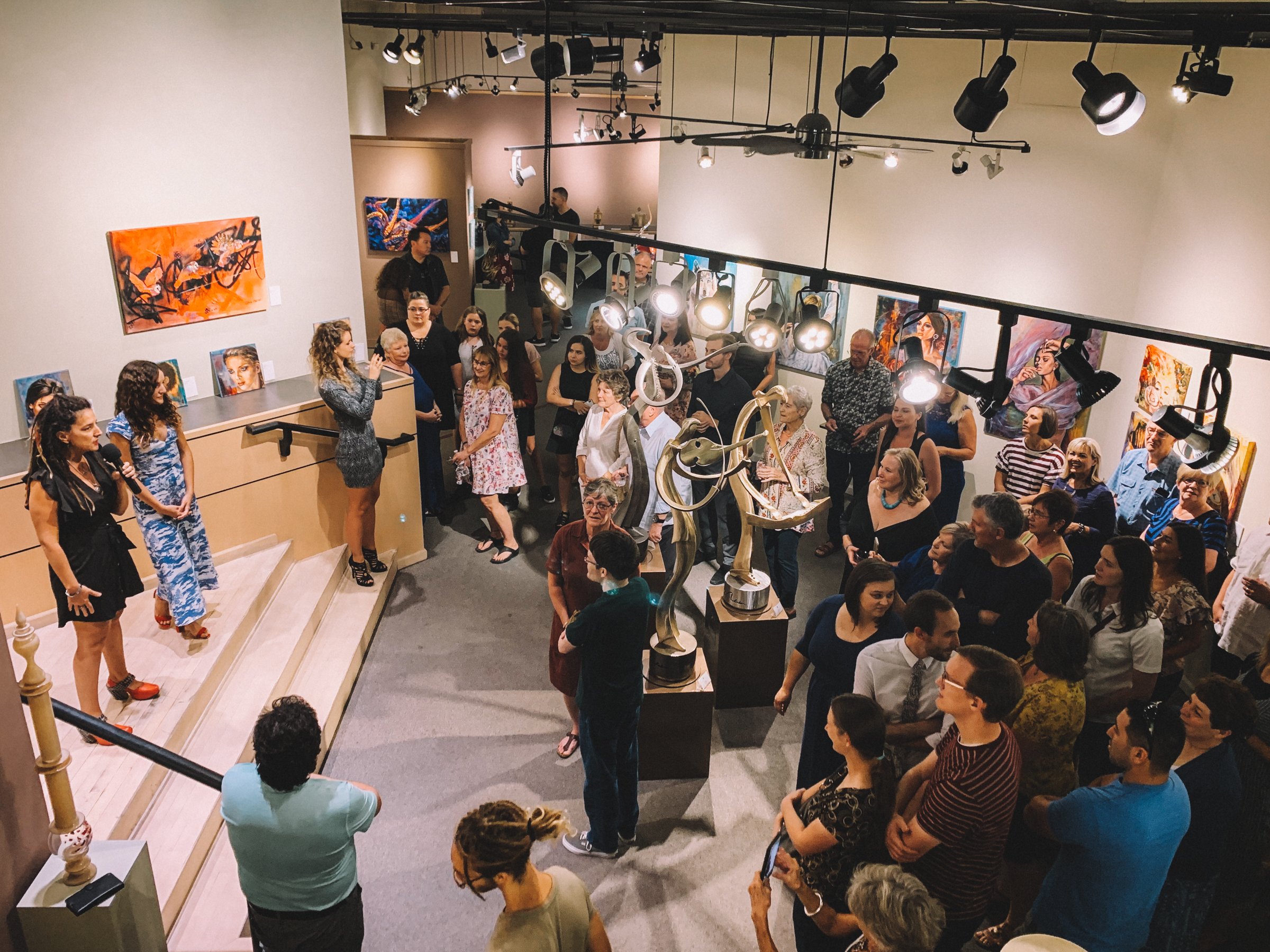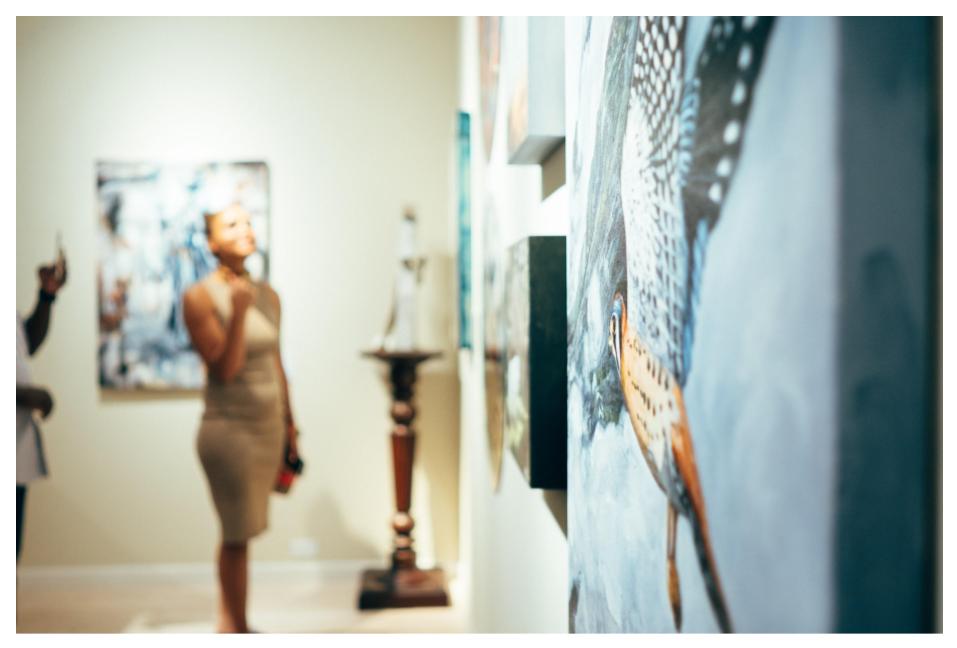Source: Milan Art Insitute.
Walking into a gallery and seeing your own artwork on display is a transformative experience for any artist. In this guide, we’ll explore strategic steps you can take to get your art into a gallery. We’ll also reveal the crucial foundation of gallery representation that artists often overlook.
Develop a Strong Portfolio
To capture the attention of gallery owners and curators, create a cohesive and compelling portfolio that demonstrates your artist identity through a consistent style and vision, providing a snapshot of your artistic journey.
A strong portfolio typically includes at least 30 paintings. That said, prioritize quality over quantity. A smaller selection of your best and most representative pieces will leave a more lasting impression than an overwhelming display of varied works. Aim for a portfolio that tells a story about your artistic evolution.
If you work in multiple mediums, consider showcasing a diverse yet interconnected range of pieces to demonstrate your versatility and the breadth of your artistic skill.
Capture high-quality images for your art portfolio by using a high-quality camera (like an iPhone X or better) and professional photography techniques, including:
- Excellent lighting
- A tripod for sharp images and close-up shots
- Editing software to enhance your photos
Include engaging descriptions of your work and the inspiration behind it to reinforce your unique style and tell your story.
Maintain a Strong Online Presence
Galleries often research artists online, so ensure your digital presence is strong and accurately represents your artistic identity.
Your online presence should involve three key elements:
- A professional website
- Social media engagement
- Consistent branding
Create a professional website that serves as a digital portfolio. Ensure it’s user-friendly, visually appealing, and provides comprehensive information about you, your artistic journey, and your exhibited works.
Your artist website should include your:
- Artist Statement
- Digital portfolio showcasing a diverse range of work
- CV (artist resume highlighting achievements, awards, and other accomplishments)
Leverage social media platforms to share your art, engage with your audience, and connect with fellow artists and galleries. Consider platforms designed for visual arts, such as Instagram, Pinterest, or TikTok. Regularly update your profiles with new content, giving followers insight into your creative process.
Maintain consistent branding across all online platforms. Your brand is you, the artist; it’s not just about your art. A strong artist brand represents your unique artistic voice and style and expresses your vision and mission. From your website to social media accounts, a unified visual and narrative identity helps establish a memorable and recognizable presence.

Establish a strong online presence to boost your credibility and develop a consistent brand as an artist. Photo courtesy of Milan Art Institute.
Research Galleries
Identify galleries that align with your artistic style and medium. Look for galleries that exhibit work similar to yours and have a reputation for supporting emerging artists.
Start by visiting the official website of galleries that catch your interest. Explore the galleries’ social media platforms and follow them to stay updated on their activities, exhibitions, and any calls for artist submissions. Browse art magazines, websites, and blogs that feature information about the galleries and their exhibitions. Look for reviews and testimonials from artists who have previously exhibited at the gallery.
Most galleries have dedicated sections for artists, exhibitions, and submission guidelines. Study each gallery’s requirements for proposals, portfolios, and exhibition proposals. Pay close attention to the list of materials the gallery requires for submissions. These requirements may include a resume, artist statement, portfolio images, and any additional information they deem necessary. Also, note any submission deadlines so you can plan and give yourself enough time to prepare and submit a polished proposal.
Some galleries use specialized platforms like Submittable or SlideRoom for artist submissions. Check if the gallery you’re interested in has a preferred platform and familiarize yourself with the submission process on that platform.
Embark on a personal, educational field trip, visiting galleries in person. Assess whether your artistic style aligns with the gallery’s overall aesthetic. A gallery with a contemporary focus might not be the best fit for a traditional or classical artist, and vice versa. Take note of the artists currently represented or exhibited by the gallery to get an idea of the caliber and style of artists the gallery is interested in.
Observe how the gallery engages with its artists. A gallery that actively promotes and supports its artists will likely be a more fruitful partner for your art career. Look for signs of collaboration and ongoing relationships.
Find out about the gallery’s owners, their price points, and their goals for the gallery. If you have questions not addressed in the submission guidelines, take a proactive approach and contact the gallery directly via a polite and concise email to clarify any uncertainties.

Building relationships is a crucial step toward getting your art into galleries. Photo courtesy of Milan Art Institute.
Build Relationships
With ambition, excitement, and courage coursing through your veins, you might boldly walk into the gallery to introduce yourself and request representation. Your bravery is worthy of reward, but building relationships is a better strategy for gallery representation than cold calling.
Galleries receive countless calls from new artists vying for their support. You’ll stand out from the crowd by putting in the time and effort necessary to build a relationship with the gallery rather than adding to that ever-growing list of cold phone calls and messages. If you don’t have a relationship with a gallery, they have little motivation to invite you into their gallery family.
So, how do you build relationships in your pursuit of gallery representation? Attend gallery openings, art fairs, and networking events within the art community. Extend your networking efforts online by joining art-related forums, engaging in art communities like the Milan Art Community, participating in virtual events, and engaging with professionals in the field. Digital connections can be just as valuable as those made in person.
Building those relationships will help you find the gallery that believes in you and does a great job selling your art. It’s worth the time and effort.
Submit Professional Proposals
Once you’ve identified some galleries that suit you well, contact them by email. Your email proposal should include:
- A professional and compelling introduction. Think of this as your cover letter. Introduce yourself and your art, and explain why you believe your work would fit the gallery well. Highlight your artistic journey and inspirations, too.
- A well-written artist statement. Your artist statement provides insight into your creative process, influences, and the thematic elements present in your work.
- High-quality images of your work. Include three or four photos that represent your best work and showcase the elements of your art that would appeal to the gallery based on your research.
Customize your proposal submissions for each gallery, addressing specific aspects of your work that align with their focus and aesthetic. Tailor each proposal to the gallery specifically—don’t just copy and paste everything from one proposal to the next. Be authentic and genuine. This personalized approach demonstrates your commitment and understanding of the gallery’s mission.
Be Persistent and Patient
Getting into a gallery takes time, and rejection is a part of the process. You can expect only around 10% of the galleries you contact to get back to you. Be prepared for potential rejections and view them as a learning experience. Seek feedback when possible, and use it to improve your work and presentation.
Becoming a professional artist takes time and a lot of hard work. Creating a strong portfolio of exceptional and sellable artwork, building an online presence, researching art galleries, and building relationships are all part of the process. Be persistent and keep at it.

Learning how to get your art into galleries is one of the key components of becoming a professional artist. Photo courtesy of Milan Art Institute.
Create Sellable Art
Sellable art is the foundation of gallery representation—a crucial step many artists skip in their eagerness to advance their art careers. Art galleries are in the business of making money. If you want a gallery to sell your art, you must create art that sells and fits the gallery’s market.
Conduct market research to understand what types of art are currently popular and sought after. Develop versatility in your artistic practice to create art that resonates with a broader audience and increase your chances of attracting gallery interest and potential buyers.
Creating sellable art doesn’t mean you have to “sell out” and produce art you don’t enjoy or that doesn’t fit your artistic voice. Download our free ebook to learn How to Create Authentic Art That Sells and find the balance between what’s trending and your artistic voice.
After You Get Your Art Into a Gallery
Your job as a professional artist doesn’t end when you finally get your art into a gallery. Focus on establishing long-term relationships. Continue investing time and effort into ensuring the success of your exhibition so the gallery benefits from it, too.
Work closely with gallery owners and curators to ensure mutual success and continued collaboration. Actively participate in gallery events, openings, and exhibitions. Your presence at these events supports the gallery and provides an opportunity for networking and connecting with other art enthusiasts.
Leverage your online presence to promote your work and the gallery. Collaborate on marketing initiatives and engage with your audience to enhance both your brand and the gallery’s reputation.
Become a Professional Artist With Gallery Representation
Getting your art into a gallery involves a strategic combination of artistic excellence, networking, and perseverance. Following the tips in this post can increase your chances of securing representation and propelling your art career to new heights.








